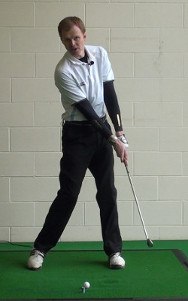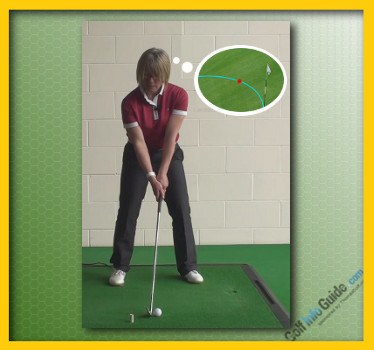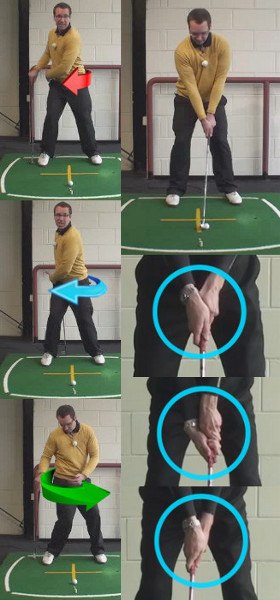
“You swing your best,” Bobby Jones
once said, “when you have the fewest things to think about.”
Playing thought-free golf is a fantasy for most of us. The swing's infinite array of minute movements – any of which can wreak havoc when mistimed – create a brain-cramping swirl of impulses. In golf, a muddled mind makes a mess of the body.
So it's best to think as little as possible immediately before and during the swing. But with so much to consider, how do you boil it all down to one or two basic keys?
The trick is to identify what goes right on your best shots. (Conversely, what goes wrong on your bad ones.)

Let's say you have a tendency to lift the left shoulder before impact, resulting in thin or pushed shots. When your left shoulder stays down, your contact is solid. Therefore, your last thought before taking the club back might be, “Left shoulder down,” or a variation that works or you.
Adding a second swing thought can work, too. For instance, “Low and slow takeaway.” If you carry two keys, mentally repeat them in their order of occurrence during the swing. (“Low and slow takeaway, left shoulder down.”)
The idea is to limit swing thoughts and keep them simple. Before long, you may need none at all.

Keep Swing Thoughts Short, Simple
While you might not know it, your mind is actually the most powerful tool you have at your disposal on the golf course. Sure, it's great to launch long drives and roll in long putts, but you are only going to score well on a regular basis if you are able to control the way you think. From having confidence in yourself to picking the right clubs, selecting smart targets, and much more, your brain is the biggest determining factor in your score for any given round. Use your brain to your advantage and golf becomes a much easier game.
Unfortunately, the vast majority of amateur golfers don't use their brains in a way that will benefit their game. In fact, most golfers think in a way that is counterproductive to the process of shooting low scores. There is a lot that goes into playing good golf from both a physical and mental standpoint, so you can't afford to fall down on the job at any point along the way. Since the physical part of the game is so challenging, it only makes sense that you should do your best to absolutely nail the mental side. With a great mental game on your side, you will be a huge step closer to playing high quality golf.
One of the big components of the mental side of the game is swing thoughts. A swing thought can be described simply as something that you are thinking while you are in the act of swinging the club. These aren't thoughts that you have before the shot takes place, although those are important too. The thoughts that run through your head from the time the club starts back until the point you are finished with the swing are critically important to the quality of your play. Focusing your mind in a positive direction during your swing will go a long way toward raising the level of your play all the way around the course.
As you might have guessed from the title of this article, short and simple swing thoughts are the most-effective when you get out on the course. Golf is a complicated game by nature, so keeping it simple whenever possible is the best way to go. If you overwhelm your mind with various thoughts and ideas, you will only damage the quality of your swing. The purpose of your swing thoughts should be simple – to allow your natural talent to shine through when it matters the most. Almost anyone can produce some decent shots on the driving range, but it takes a good player to move those shots out onto the course. The inability to transfer performance from the range to the course is one of the biggest complaints that you will hear from amateur players, and it all starts with having good swing thoughts to lean on.
All of the instruction below is based on a right handed golfer. If you happen to play left handed, please be sure to reverse the directions as necessary.

How to Find the Right Swing Thoughts for You
Many golfers struggle with the task of determining the right swing thoughts to use on the course. This is a challenge because you can't just 'steal' your thoughts from another player. The swing thought or thoughts that you use have to apply specifically to your swing and your game if they are going to do any good at all. Without importance to your game, you will quickly give up on a swing thought because it won't be doing anything to help you anyway.
So how do you know what kind of swing thoughts to use? The answer can be found on the driving range. When you are on the range working on your swing, what parts of the swing give you the most trouble? Is there one or two areas of your technique that you are constantly having to fix? The majority of golfers are plagued by the same issues round after round, year after year. If that sounds like you, the answer to the swing thought puzzle should be obvious. Develop a swing thought that is specific to the problems you are dealing with in your technique, and you will be well on your way toward improved performance.
This concept will be easier to understand when highlighted by an example. Imagine for a moment that you have trouble with your left arm getting up and away from your body during the backswing. This is an issue that is faced by countless amateur golfers, so there is a good chance that you can relate to this problem. When the left arm drifts away from your body, the swing becomes disconnected and it will be a challenge to time everything properly at impact. On the range you are able to keep your left arm connected nicely to your side, but you struggle with that part of the swing when you are actually on the course.
To get your game on track, your swing thought should relate to this left arm issue. If you are thinking about keeping your left arm down during the backswing, your body will likely respond by getting the job done. It is only when you forget about the issue that it is going to pop up once again. So, if during every swing you think about the position of your left arm, your performance on the course should quickly live up to what you are able to do on the practice range.
This is a good example of a quality swing thought because it addresses a specific problem that you are facing with your swing. Of course, if you don't actually have any issue with the position of your left arm, you will need pick out something in your swing that should be improved. Chances are, even as you are reading this article, you can think of something right off the top of your head that you would like to improve. There is no such thing as a perfect golf swing or a perfect golfer, so everyone has something they can address. From the best players in the world down to the total beginner, all golfers have a need for clear and simple swing thoughts.

What Makes a Good Swing Thought?
Not every potential swing thought is a good one. Even if you pick out something that is related to your swing problems, it still might not be a good thought if it doesn't allow you to play your best golf when it matters most. So what it is that makes a good swing thought? Any thought you are going to use on the course should meet the following three criteria –
- It must be simple. You will never have great success while using a complicated swing thought. If there are multiple steps to your thought, or if you have to execute a number of different moves in the swing in order to carry out the idea behind the thought, it is never going to work. Keep it simple – extremely simple. In the example above, the only thought is keeping the left arm in close to your chest. That's it. That is a perfect example of something that is simple, easy to remember, and easy to execute. As you go through the process of developing your own swing thoughts, simplicity should be at the top of your mind.
- It applies all day long. It would be a mistake to develop a swing thought that is only going to apply on some of your shots. For example, using a specific swing thought that only help you when you are trying to play a draw could be helpful some of the time, but it won't apply to every shot that you hit. In order to keep your game as simple and as repeatable as possible, your thoughts should be applicable throughout the round. If you do need to adjust your ball flight to do something like hit a draw or fade, you should make those adjustments prior to even standing over the ball. Once you have taken your stance, shift your focus to your go-to swing thought and make a great move. For the average amateur golfer, going back and forth between a variety of swing thoughts depending on the shot at hand is going to be too much to ask, so find a thought that covers all of your swings and master it.
- It gives you confidence. Everything you do on the course should be built around instilling confidence in your mind. Doubt will ruin even the most talented player, as no golfer is good enough to play their best while thinking negatively about their abilities. You need to have confidence to play good golf, and having a positive swing thought can be a big help in developing that self-belief. When you stand over the ball to start your swing, you should feel comforted by your swing thought, knowing that it is going to help you deliver the kind of swing you need to attack the target successfully.
If your swing thought doesn't meet all three of the criteria above, throw it away and start over. Only thoughts that meet these three points deserve closer consideration, so take some time to come up with a list of ideas and then narrow that list down until you have a winner. For now, you should have just a single swing thought that you are going to take with you on the course. Over time, you may need to adapt that swing thought as new problems develop in your swing. For instance, if you are currently using the 'left arm' swing thought from above, you might find that eventually you don't need that thought anymore to keep you on track. So, instead, you could switch to a thought about your lower body, head position, or anything else that helps you play your best. You don't have to commit to a single swing thought for the rest of your golfing career, but you should at least pick on that you are going to stick with for the time being.

The End of a Pre-Shot Routine
It might be helpful to think about your swing thoughts as being the completion of your pre-shot routine. You do use a pre-shot routine, right? If not, now is the time to start. A big part of having a complete mental game is using a quality pre-shot routine, as this routine is just as important as your swing thoughts. Just like a great swing thought can help you execute your best swing, a good pre-shot routine can go a long way toward putting you in the right frame of mind to send the ball toward your target with consistency.
So if you are going to get the best possible production from your swing thought, you first need to have a good pre-shot routine in place. While there is plenty of room for individuality in your routine, the basic outline should look something like the process below.
- Arrive at your ball and assess the situation in front of you. If you are walking the course, that means setting your bag down, and if you are riding, you need to get out of the cart and stand near your ball. Take a close look at the kind of lie you have in the grass (or sand), and get a yardage to the target. Of course, if you are preparing to hit a tee shot, you won't need to worry about reading the lie.
- Once you know what kind of shot you are facing, the next step is to pick a club. Take all factors into consideration when making your club selection, and only pull a club out of the bag when you are totally convinced that you are holding the right one.
- With your club in hand and your shot selected, it is time to prepare for making a swing. Stand a few feet behind your golf ball and look directly down the target line. If you like to make a practice swing before hitting your shot, this is the time to do it. However, many players perform better with no practice swing, so don't feel like you have to make one just because you see other players doing it. Try your routine both with a practice swing and without to decide which option you prefer.
- Next, you should do you best to clear your mind while still standing behind the ball. That means you should force out any bad thoughts about pressure or hazards that are waiting to catch your ball, and bring in only positive thoughts and feelings. Picture your ball sailing toward the target, and take a nice deep breath to relax your body.
- With a deep breath taken, walk up to the ball and take your stance. Many golfers rush through this part of the routine, but it is important that you take this portion very seriously. Building a great stance is crucial to hitting good shots, so now is not the time to cut corners. Take a moment to settle in to your stance and make sure you are comfortable over the ball.
- At this point, everything has been done and it is time to send the ball on its way. As you prepare to start the takeaway, put your swing thought into your head and keep it there until the ball is gone. No matter what your swing thought is, put it at the front of your brain and focus on it alone while you are making your swing. A clear swing thought, along with a good pre-shot routine, will help you play your best golf.
Do you remember the last time you saw a golfer practicing his or her pre-shot routine on the driving range? It has probably been a while, and it may be that you have never seen it. That's because most amateur golfers don't value the pre-shot routine like they should, and they pay the price on the course. Now that you understand the importance of this part of the game, you should work on it at the range just like you work on anything else. Try to complete your pre-shot routine prior to most of your swings on the range, so that your body can get used to it just like it gets used to your swing mechanics. It will take longer to go through a bucket of range balls when you are doing a pre-shot routine before every swing, but your practice sessions will become far more beneficial.

Short Game Swing Thoughts
You probably haven't thought about it before, but your short game needs swing thoughts just like you need them in the long game. Even though the short game is simpler in terms of technique, you still want to make sure you are executing to the best of your ability each and every time. If you can come up with a specific swing thought for your short game shots, you should be able to improve your performance.
The best way to handle this part of the mental game is to have a swing thought for your putting stroke, your chipping/pitching shots, and your sand game. That means that you will need to have three unique swing thoughts, each of which applies to the shot that you are hitting at the time. Add that to the swing thought that you are using for your full swing, and you will have a total of four thoughts that will carry you through the round.
If you would like some help coming up with your swing thoughts for the short game, take a quick look at the tips below.
- Putt with the shoulders. Most golfers would benefit from using their shoulders more and their hands less in the putting stroke. With that in mind, try to create a swing thought which focuses on using the big muscles of your upper body to move the putter and back and through the ball. By rocking your shoulders instead of using your hands, you can move the putter through impact with a steady speed. Try using a few different thoughts on the practice putting green until you find one that gives you confidence and leads to good results.
- Chipping through the ball. A large number of amateur golfers are intimidated by chip shots, so they slow the club down as they come into impact as a result. The key to good chipping is confidence and simple technique, so find a thought that helps you gain some clarity over the ball. For example, you may wish to focus on keeping the back of your left wrist flat through impact. If you can do that successfully, you should be able to hit down crisply through the ball and make nice contact. A breakdown in your hands is a disaster when it comes to chipping, so the left wrist is a great starting point for your chipping swing thought.
- Release in the bunker. In many ways, hitting a bunker shot is the exact opposite of hitting a chip shot. In chipping, you need solid hands, but when playing from the bunker, you need to release your hands aggressively in order to move the club head through the sand. Therefore, use a swing thought that promotes active hands through the ball. For instance, you could try thinking about firing your right hand through impact while digging the club into the sand to toss the ball up and out of the bunker safely.
If you have aspirations of becoming a better golfer, you simply can't afford to ignore the importance of swing thoughts. By crafting swing thoughts that keep the game simple, you will increase your chances of hitting the same kinds of shots on the course that you are able to hit on the range. Take the time to work on finding good swing thoughts for both your full swing and your short game, and you will be better prepared for your next trip onto the course.






